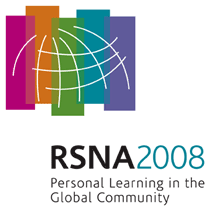
Abstract Archives of the RSNA, 2008
Marjolein Henrieke Liedenbaum MD, Presenter: Nothing to Disclose
Anne Floortje van Rijn MD, Abstract Co-Author: Nothing to Disclose
Ayso Harmen de Vries MD, Abstract Co-Author: Research grant, Koninklijke Philips Electronics NV, Best, Netherlands
Francois Willemssen MD, Abstract Co-Author: Nothing to Disclose
Evelien Dekker MD, PhD, Abstract Co-Author: Nothing to Disclose
Jaap Stoker MD, PhD, Abstract Co-Author: Research support, Koninklijke Philips Electronics NV
To determine CT-colonography (CTC) accuracy in persons with a positive Fecal Occult Blood Test (FOBT) for all lesions and adenomas ≥10 mm and ≥6 mm.
In three different institutions, 270 consecutive FOBT positive screening individuals (55 guiac FOBT, 215 Fecal Immunochemical Test) underwent CTC. They received an iodine fecal tagging agent and non-fiber diet as limited bowel preparation. Each CTC was read by two of seven independent, experienced observers (>125 CTC’s with colonoscopic verification). CTC was performed on a 64 slice scanner using a low dose protocol with dose modulation (120 kV, 40 or 32 ref mAs). Within 3 weeks after CTC, colonoscopy with segmental unblinding was performed (reference standard). For CTC and colonoscopy per polyp and per adenoma sensitivity and for CTC per patient sensitivity and specificity were calculated for both observers (‘double reading’) after polyp matching with two cut-off points: lesions ≥10mm and lesions ≥6mm. False negative (FN) findings were classified as perceptive (pFN, retrospectively visible) or technical (tFN, not visible).
In total 20 (7%) of FOBT positive patients had a carcinoma; CTC sensitivity for carcinoma was 95% (95% CI: 91-99%) with a flat rectal carcinoma as FN finding. In all FOBT positive patients 181 lesions ≥10mm were found in 127 (47%) patients and 338 lesions ≥6mm in 184 (68%) patients. Per polyp sensitivity for CTC was 93% (95% CI: 88-98%) for lesions ≥10mm and 88% (95% CI: 82-94%) for lesions ≥6mm. Per adenoma sensitivity was 94% (95% CI: 90-99%) for adenomas ≥10mm and 89% (95% CI: 83-95%) for adenomas ≥6mm. For lesions ≥6mm pFNs were: 3 flat, 7 sessile and 2 pedunculated lesions. tFNs were: 11 flat, 16 sessile and 3 pedunculated lesions. Per polyp sensitivity for colonoscopy was 97% for both size categories. Per patient sensitivity for CTC was 96% (95% CI: 92-100%) and 94% (95% CI: 89-99%) for lesions ≥10mm and ≥6mm respectively. The per patient specificity was 93% (95% CI: 88-98%) and 80% (95% CI: 72-88%) for lesions ≥10mm and ≥6mm respectively.
CTC with limited bowel preparation is an accurate technique for carcinoma and adenoma detection in a FOBT positive screening population.
In a FOBT positive screening population CTC has high diagnostic accuracy and can be used to identify patients to be referred to colonoscopy.
Liedenbaum, M,
van Rijn, A,
de Vries, A,
Willemssen, F,
Dekker, E,
Stoker, J,
CT Colonography for Detection of Colorectal Neoplasia in a FOBT Positive Screening Population. Radiological Society of North America 2008 Scientific Assembly and Annual Meeting, February 18 - February 20, 2008 ,Chicago IL.
http://archive.rsna.org/2008/6012336.html

